
|
Note ye ed's email address: stevebryant99@gmail.com. |

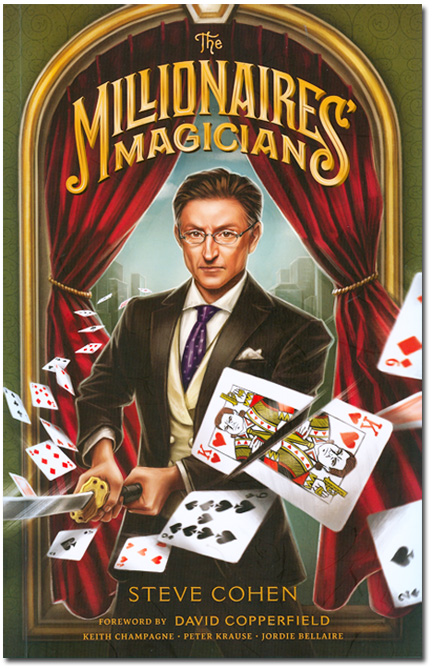
Steve Cohen, action hero.
|
Return to our Halloween issue for a look at Simon Coronel's play Glitches in Reality, Geoff Latta's The Long Goodbye, and Harry Lorayne's And Finally! |
November 2018 Happy Thanksgiving! Specifically, let's be thankful for ... During the Bill Bixby ("The Magician") era, a kid in my birthday show audience asked if I used magic to fight crime. I had to disappoint him. (A second kid claimed he saw a magician cause a saber-tooth tiger to jump through a hoop of fire.) It was therefore a kick this month to see another magician, the normally mild-mannered Steve Cohen, fighting crime himself, if only in the context of a (sensational) graphic novel. Along with Steve's exploits we look back at the first of nine volumes of Nick Trost's Subtle Card Creations, at a knee-buckling card trick from Woody Aragon, and at a Halloween broadcast from DJ Milt Larsen. And finally, check out the box in which my first "professional" magic trick came in, during the few months of junior high that I lived in St. Petersburg, Florida. I still have it! |
|
|
CRIME DOES NOT PAY -- The first crimefighting magician in my ken was Mandrake, accessible in the Sunday comics. Lee Falk's top-hatted lawman thwarted crime with sensational magic via the hypnotic gestures he learned during his years in Tibet. A dozen years after Mandrake's 1934 debut came the premiere of Blackstone Master Magician Comics (featuring "Blackstone The Only Living Comic Book Character"). Also a living character, though neither a comic strip one nor a crimefighter, is Ricky Jay, who nevertheless introduced the idea of Cards as Weapons. (As Ricky puts it, "Drawing on techniques used hundreds of years ago by ninja assassins.") 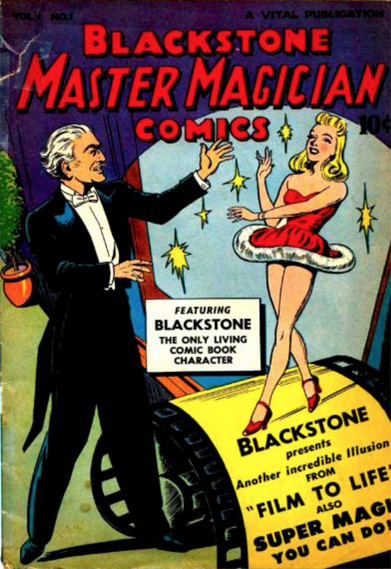 First live master magician comic? And now along comes a new comic book magical hero, Steve Cohen, starring in his graphic novel The Millionaires' Magician. Like Mandrake, this comic hero fights crime. Like Blackstone, the character is based on a real-life master magician. Like Ricky Jay, the character uses magic tricks as weapons. I found the story immediately gripping and lots of fun. In an opening performance something goes horribly awry with an eight-million-dollar Ring to Lemon to Egg to Walnut. (You can see the real Steve do it successfully on Letterman) Not only does the ring go missing, but it belonged to a secret underworld kingpin engaged in a particularly nefarious form of human trafficking. And as if he weren't bad enough, his assistant is a regular Lady Macbeth. 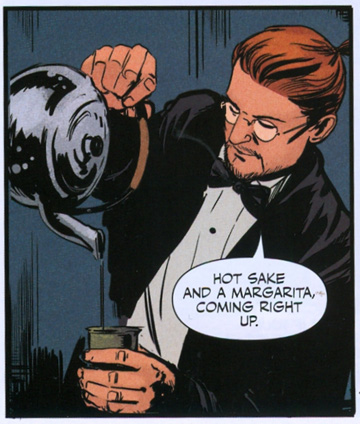 Art imitates life. It's a magician's tale, rich with magic tricks. Over the course of his extensive battles with evil, action hero Steve finds time to perform, among others: Card Sword, Bill Switch, Ring to Nut, Think-a-Drink, Cardistry, Card on Seat, Fountain Pen to Bread, Chinese Linking Rings, Necklace Production, Spectator Cuts to Queens, Talking Skull, Self Levitation, Fruit Transposition, and Bullet Catch. A Card Star lurks in the background in several scenes. Occasionally the battles and the magic tricks converge. I was surprised when Steve whammed someone upside the head with his treasured teakettle or subdued a pair of baddies with a set of Linking Rings. Flash paper erupts at just the right moment, and you may want one of those Houdini card clips. As a graphic novel The Millionaires' Magician is gorgeous. Lines are sharp and colors are vivid. Batman-like THUNKs and KR-RACKs and WHOOSHes abound. Key scenes are rendered in grandly enlarged panels. The story unfolds at a rapid pace, and there is admirable economy in how the plots of magic tricks and the action scenes are conveyed.  Max reveals all. Like Cary Grant, Steve Cohen seems to have invented himself and truly lives the life of a Millionaires' Magician. In his graphic novel he re-invents himself as an action hero, but with semi-autobiographical parallels. Like real Steve, action-hero Steve apprenticed in Japan, both characters fluent in the language. (My childhood hero Mandrake also apprenticed in the East.) Real Steve and action-hero Steve perform all the same magic tricks, in the grand manner of the chamber magic days of Hofzinser. Real Steve did indeed entertain at the Park Hyatt hotel in Tokyo, had a part-time job at Magic Land under Ton Onasaka, and of course performed for years at the Waldorf Astoria. Real Steve's wife and action-hero Steve's love interest are both named Yumi. Author Steve included allusions to or direct mention of his own magical heroes in the book: Max Malini, Frederick Eugene Powell, Ton Onasaka, and David Copperfield. And, once, Steve did indeed perform the Bullet Catch, but was injured by flying glass. These guys are too good not to mention: Conceived by Steve Cohen, story by Keith Champagne, art by Peter Krause, coloring by Jordie Bellaire, lettering by Bill Tortolini, cover art by Tara Phillips, and book design and cover lettering by Spencer Charles. There is a Foreword by David Copperfield, an Epilogue by Steve Cohen, and a reprinted Genii interview with Steve. Add to this impressive testimonials from Michael Uslin and Peter Sagal. Softbound, full color, 120 pp, $24.99 or $49.99 autographed. I bought mine directly from themillionairesmagician.com. |
|
|
OVERDUE BOOK REPORT -- I've been praising the Nick Trost's Subtle Card Creations series ever since H&R Magic Books began churning them out in 2008. As longtime readers know, six of an expected nine volumes are currently in play, all wonderful, and I've recently learned that Volume 7 has been slightly delayed until spring 2019. In anticipation of the next installment, I read back over my musings on the first half dozen, consolidated in my March 2017 issue. Although I commented on all six books over the years, I failed to fully explore the initial volume from 2008, perhaps because H&R and I were also busy that year putting out The Little Egypt Book of Ghosts. Whatever, this strikes me as a perfect opportunity to rectify the omission, hence I have just enjoyed re-reading Volume 1. 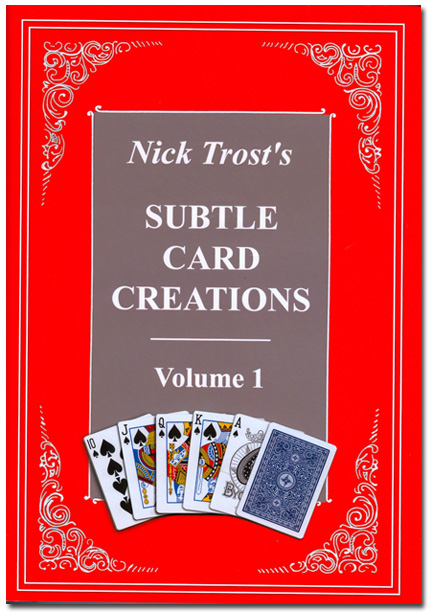 The book that started the H&R Trost library. To repeat my previous thoughts on the book: First, in the Introduction, Nick Trost details what distinguishes his card magic: "Most of the tricks require little or no sleight of hand. They are based primarily on clever principles, procedures and subtleties. My goal has been to get the maximum effect with a minimum of effort." Second, and this is so far true of the series, this is the only volume to contain an appendix of sleights and subtleties. This appendix is one of my favorite spots in my library, with over 40 potent ruses (moves, counts, forces, false shuffles, etc.) for accomplishing most modern card magic. I refer to it frequently to keep my knowledge and skills in tune. The series begins with a generous range of chapters: Unique Card Effects, Coincidences, Court Card Capers, Gambling Tricks, Poker Tricks, Predictions, Transpositions, Fake-Card Foolers, Special Decks - Part 2, Packet Tricks - Part 1, ESP Cards - Part 1, and (already mentioned) Appendix: Sleights ad Subtleties. A few individual tricks I found special: Jacks Are Wild with an Elevator Finish: Show a poker hand of five jokers. They instantly change into five jacks. The jacks are then inserted one by one into the deck where they travel up and down in elevator fashion. You end clean. Sympathetic Suits: Deck is fairly shuffled. The hearts and spades are extracted and the hearts are set aside. Spectator reverses any card in the spade packet. The spades are now dealt to the table, switching whenever the spectator says so. The two packets are placed side by side and their order revealed, an exact match, even the reversed card. 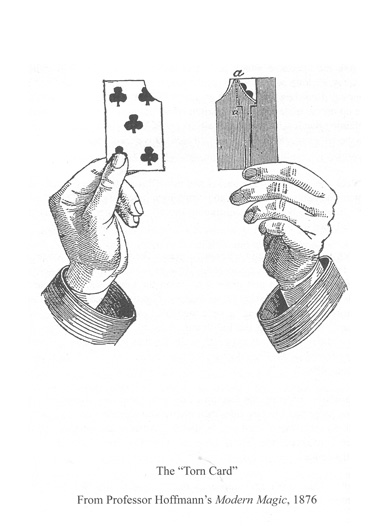 Vintage decor. Wild Bill's Poker Hand I: This one enticed me to re-read the entire book. Two hands are dealt. Wild Bill gets the expected two pair, aces and eights, and his partner Charlie Rich gets an unknown hand. A shot rings out! But not over a lowly two pair. Charlie has four eights, Wild Bill has a royal flush. Wild Bill's Poker Hand II is the same effect but with a different and just as easy method. Ambitious Ace to Five: Show five cards, AC through 5C. AC is placed second from top and it rises to the top. This is repeated with the 2C, 3C, and 4C. The 5C changes to the 5D. It doesn't get any easier. Fifteen-Card Mystery: Trost's version of the Traveling Card from Marlo's The Cardician. A selected card moves from one packet of five to another. And another. Trost on Hamman's Magic Cards: With minor modifications* this is my favorite in the book. Three random cards are placed face down in a row on the table, say AD, 4S, and KD. A packet of three "magic cards" (jokers) is removed from the pocket and dropped onto the AD. All four cards are now shown to be ADs. The jokers are then dropped onto the 4S, and each of the four cards becomes a 4S. And so on with the KD. The displays look really clean. Finally, the three jokers are once again shown to be jokers. I notice that my selections above gravitate to the use of the Diminishing Count, an easy and deceptive sleight. If you like the sleight, you will love the routines. But then all of the routines in the book are easy, which was Nick Trost's gift to us. In all, a fine book of card tricks, harbingers of wonderful tricks to come. The book features a Foreword by Karl Fulves and a brief Introduction by Nick Trost. Hard cover, dust jacket, nicely illustrated by Tony Dunn, and decorative vintage line art, in what would become the usual H&R Magic Books/Trost series format. Alas, although Volumes 2 through 6 are still available, I no longer see Volume 1 on the H&R web site, so good luck. This gives you insight into the secret of my success--timing! |
|
|
Sometimes wonderful things are as close as your wi-fi. Here are two of recent interest. I PREDICT -- I rarely buy single card tricks these days, but cannot overlook Woody Aragon's Fortune Tarot. This is the cleverest card trick I have seen since Tomas Blomberg's Late Key, from Andi Gladwin's Blomberg Laboratories.  Nine-card magic square. The trailer is almost as good as the real thing. Under the pretext of telling someone's fortune, you invite her to cut off a few cards, less than half. These cards are set aside. You overhand shuffle the remainder a bit, then offer to let the spectator shuffle. She cuts the deck in half, turns half face up, and riffle shuffles the halves together, Triumph style. Optionally you can mess up the deck even more. Finally, you deal the top nine cards into a three by three matrix, some face up, some face down. Any row adds up to, say, 11, her "fortune." (References to Douglas Adams' 42 are appropriate.) Each row, column, and finally the diagonals add to 11. Oh, those cards originally set aside? She counts them. Eleven! Ah, her lucky number. What kind of mind concocts these Magic Square miracles? On this download from Penguin, Woody walks you through the process by which he developed it, a lovely combination of layers of deception. An instant download from Penguin, $14.95. I predict this will be Woody's most popular effect since How to Find Your Other Half from A Book in English. IN HIS SPARE TIME -- When Milt Larsen isn't busy creating magical castles or producing theatrical magic shows or collecting variety arts memorabilia or opening for Amazing Johnathan or writing biographies about when he wrote for "Truth or Consequences" or posting on his Milt-ing Pot blog or yanking tablecloths off dinner tables, he squeezes in a little time to serve as disk jockey for CRN Digital Talk Radio. His program "Hear Them Again (For the First Time)" airs Sunday nights at 7:00 PM Eastern. Along with his pal Richard M. Sherman, he loves to play old 78 novelty songs.  Vintage music. This past Halloween, in his role as alter ego Professor Harry Hockman, Milt departed a little from his musical offerings to play a recording of Harry Houdini, on a cylinder recording made by Thomas Edison. The recording belongs to David Copperfield. Houdini discusses his water torture escape, and he really sells it. Milt also played a recording by (supposedly) Houdini in which Houdini demonstrated his latest miracle by using a Mr. Grossman as his subject, handcuffing him, placing him in chains with ankle weights, taking an axe to the only three keys, and dumping the fellow into 3000 gallons of water, over strong protests. It was hilarious, like a Bob Newhart sketch. My apologies. I have no link to get you back to the Halloween broadcast, but mention it here for the record. Meanwhile, you can always check out Milt's future episodes. |
|
 My first "real" magic trick, Martinelz Magic Mart, 1959.
Aloha, William Goldman.
*Since you are using stranger cards anyway, it is easy to make all four cards in the first pile to be an AD, not merely aces. And so on. And I would use a Rumba Count for the final display of the jokers. Follow us on Twitter. Little Egypt Magic is the erratically updated web site of Steve Bryant, spawned (the site, not Steve) by a former internet magazine known as The Little Egypt Gazette/for magicians only. Steve Bryant is an obscure magician and writer who generates this site from an iMac in Bloomington, Indiana. He used to frequently journey to and perform magic in Little Egypt, the local name for extreme southern Illinois, where the towns bear such names as Cairo, Thebes, and Karnak. Past issues of this web site: Index to Past Issues Notice: Any limited use of copyrighted images or quoted text is considered fair use, usually to review whatever product or event that is under discussion. If you object to use of any material, please get in touch and it will be cheerfully removed. |
A JSB Creations product
Copyright© 2018 by Steve Bryant